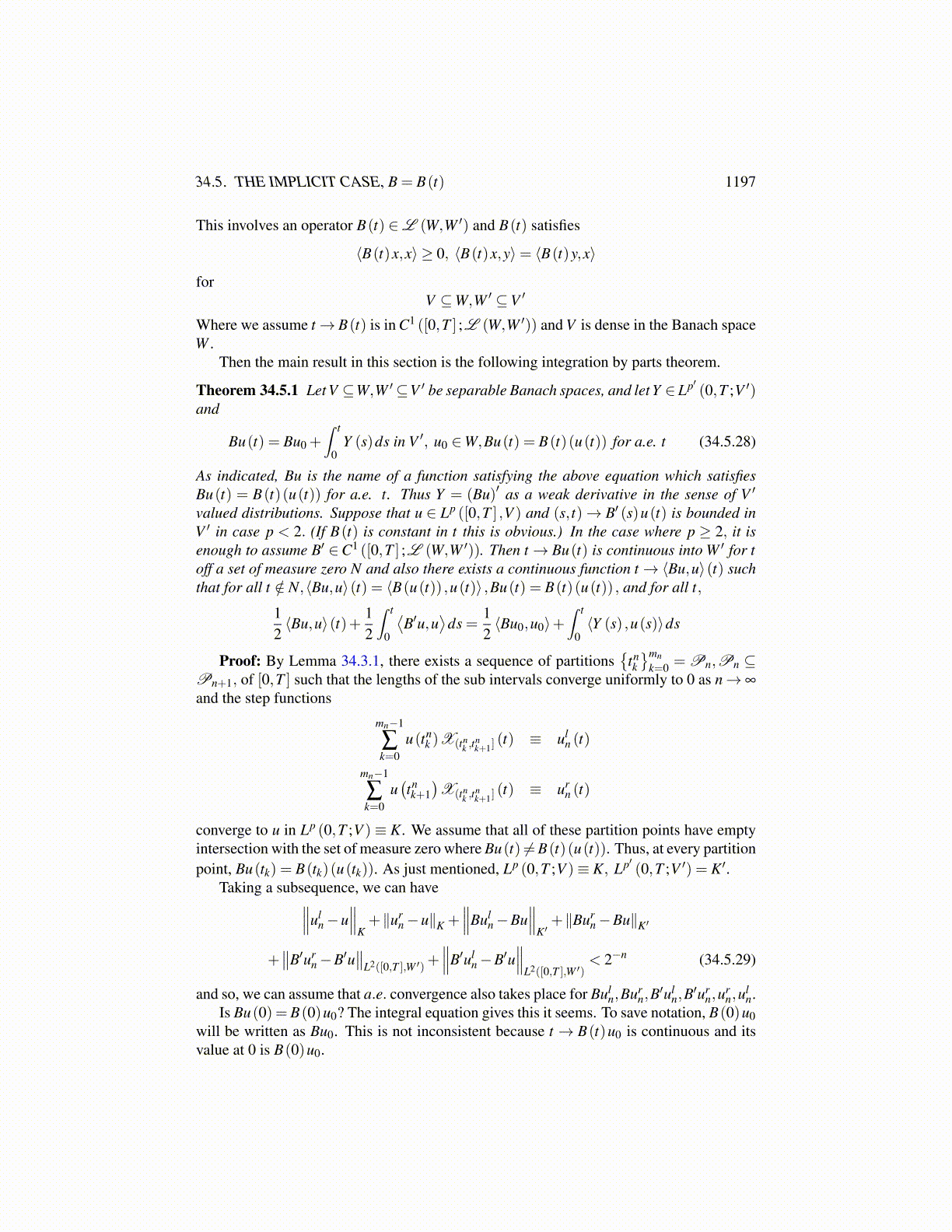
34.5. THE IMPLICIT CASE, B = B(t) 1197
This involves an operator B(t) ∈L (W,W ′) and B(t) satisfies
⟨B(t)x,x⟩ ≥ 0, ⟨B(t)x,y⟩= ⟨B(t)y,x⟩
forV ⊆W,W ′ ⊆V ′
Where we assume t→ B(t) is in C1 ([0,T ] ;L (W,W ′)) and V is dense in the Banach spaceW .
Then the main result in this section is the following integration by parts theorem.
Theorem 34.5.1 Let V ⊆W,W ′⊆V ′ be separable Banach spaces, and let Y ∈Lp′ (0,T ;V ′)and
Bu(t) = Bu0 +∫ t
0Y (s)ds in V ′, u0 ∈W,Bu(t) = B(t)(u(t)) for a.e. t (34.5.28)
As indicated, Bu is the name of a function satisfying the above equation which satisfiesBu(t) = B(t)(u(t)) for a.e. t. Thus Y = (Bu)′ as a weak derivative in the sense of V ′
valued distributions. Suppose that u ∈ Lp ([0,T ] ,V ) and (s, t)→ B′ (s)u(t) is bounded inV ′ in case p < 2. (If B(t) is constant in t this is obvious.) In the case where p ≥ 2, it isenough to assume B′ ∈C1 ([0,T ] ;L (W,W ′)). Then t→ Bu(t) is continuous into W ′ for toff a set of measure zero N and also there exists a continuous function t→ ⟨Bu,u⟩(t) suchthat for all t /∈ N,⟨Bu,u⟩(t) = ⟨B(u(t)) ,u(t)⟩ ,Bu(t) = B(t)(u(t)) , and for all t,
12⟨Bu,u⟩(t)+ 1
2
∫ t
0
⟨B′u,u
⟩ds =
12⟨Bu0,u0⟩+
∫ t
0⟨Y (s) ,u(s)⟩ds
Proof: By Lemma 34.3.1, there exists a sequence of partitions{
tnk
}mnk=0 = Pn,Pn ⊆
Pn+1, of [0,T ] such that the lengths of the sub intervals converge uniformly to 0 as n→ ∞
and the step functions
mn−1
∑k=0
u(tnk )X(tn
k ,tnk+1]
(t) ≡ uln (t)
mn−1
∑k=0
u(tnk+1)X(tn
k ,tnk+1]
(t) ≡ urn (t)
converge to u in Lp (0,T ;V )≡ K. We assume that all of these partition points have emptyintersection with the set of measure zero where Bu(t) ̸=B(t)(u(t)). Thus, at every partitionpoint, Bu(tk) = B(tk)(u(tk)). As just mentioned, Lp (0,T ;V )≡ K, Lp′ (0,T ;V ′) = K′.
Taking a subsequence, we can have∥∥∥uln−u
∥∥∥K+∥ur
n−u∥K +∥∥∥Bul
n−Bu∥∥∥
K′+∥Bur
n−Bu∥K′
+∥∥B′ur
n−B′u∥∥
L2([0,T ],W ′)+∥∥∥B′ul
n−B′u∥∥∥
L2([0,T ],W ′)< 2−n (34.5.29)
and so, we can assume that a.e. convergence also takes place for Buln,Bur
n,B′ul
n,B′ur
n,urn,u
ln.
Is Bu(0) = B(0)u0? The integral equation gives this it seems. To save notation, B(0)u0will be written as Bu0. This is not inconsistent because t → B(t)u0 is continuous and itsvalue at 0 is B(0)u0.